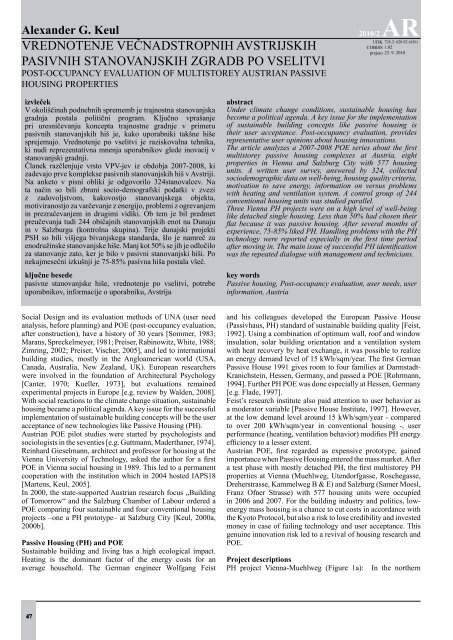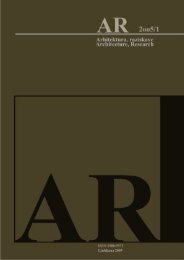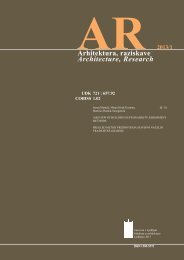AR 2010/2 - Fakulteta za arhitekturo
AR 2010/2 - Fakulteta za arhitekturo
AR 2010/2 - Fakulteta za arhitekturo
- No tags were found...
You also want an ePaper? Increase the reach of your titles
YUMPU automatically turns print PDFs into web optimized ePapers that Google loves.
Alexander G. KeulVrednotenje večnadstropnih avstrijskihpasivnih stanovanjskih zgradb po vselitviPOST-OCCUPANCY EVALUATION OF MULTISTOREY AUSTRIAN PASSIVEHOUSING PROPERTIES<strong>2010</strong>/2 <strong>AR</strong>UDK 728.2: 620.92 (436)COBISS 1.02prejeto 23. 9. <strong>2010</strong>izvlečekV okoliščinah podnebnih sprememb je trajnostna stanovanjskagradnja postala politični program. Ključno vprašanjepri uresničevanju koncepta trajnostne gradnje v primerupasivnih stanovanjskih hiš je, kako uporabniki takšne hišesprejemajo. Vrednotenje po vselitvi je raziskovalna tehnika,ki nudi reprezentativna mnenja uporabnikov glede inovacij vstanovanjski gradnji.Članek razčlenjuje vrsto VPV-jev iz obdobja 2007-2008, ki<strong>za</strong>devajo prve komplekse pasivnih stanovanjskih hiš v Avstriji.Na anketo v pisni obliki je odgovorilo 324stanovalcev. Nata način so bili zbrani socio-demografski podatki v zveziz <strong>za</strong>dovoljstvom, kakovostjo stanovanjskega objekta,motiviranostjo <strong>za</strong> varčevanje z energijo, problemi z ogrevanjemin prezračevanjem in drugimi vidiki. Ob tem je bil predmetpreučevanja tudi 244 običajnih stanovanjskih enot na Dunajuin v Salzburgu (kontrolna skupina). Trije dunajski projektiPSH so bili višjega bivanjskega standarda, šlo je namreč <strong>za</strong>enodružinske stanovanjske hiše. Manj kot 50% se jih je odločilo<strong>za</strong> stanovanje <strong>za</strong>to, ker je bilo v pasivni stanovanjski hiši. Ponekajmesečni izkušnji je 75-85% pasivna hiša postala všeč.ključne besedepasivne stanovanjske hiše, vrednotenje po vselitvi, potrebeuporabnikov, informacije o uporabniku, AvstrijaabstractUnder climate change conditions, sustainable housing hasbecome a political agenda. A key issue for the implementationof sustainable building concepts like passive housing istheir user acceptance. Post-occupancy evaluation, providesrepresentative user opinions about housing innovations.The article analyzes a 2007-2008 POE series about the firstmultistorey passive housing complexes at Austria, eightproperties in Vienna and Salzburg City with 577 housingunits. A written user survey, answered by 324, collectedsociodemographic data on well-being, housing quality criteria,motivation to save energy, information on versus problemswith heating and ventilation system. A control group of 244conventional housing units was studied parallel.Three Vienna PH projects were on a high level of well-beinglike detached single housing. Less than 50% had chosen theirflat because it was passive housing. After several months ofexperience, 75-85% liked PH. Handling problems with the PHtechnology were reported especially in the first time periodafter moving in. The main issue of successful PH identificationwas the repeated dialogue with management and technicians.key wordsPassive housing, Post-occupancy evaluation, user needs, userinformation, AustriaSocial Design and its evaluation methods of UNA (user needanalysis, before planning) and POE (post-occupancy evaluation,after construction), have a history of 30 years [Sommer, 1983;Marans, Spreckelmeyer, 1981; Preiser, Rabinowitz, White, 1988;Zimring, 2002; Preiser, Vischer, 2005], and led to internationalbuilding studies, mostly in the Angloamerican world (USA,Canada, Australia, New Zealand, UK). European researcherswere involved in the foundation of Architectural Psychology[Canter, 1970; Kueller, 1973], but evaluations remainedexperimental projects in Europe [e.g. review by Walden, 2008].With social reactions to the climate change situation, sustainablehousing became a political agenda. A key issue for the successfulimplementation of sustainable building concepts will be the useracceptance of new technologies like Passive Housing (PH).Austrian POE pilot studies were started by psychologists andsociologists in the seventies [e.g. Guttmann, Maderthaner, 1974].Reinhard Gieselmann, architect and professor for housing at theVienna University of Technology, asked the author for a firstPOE in Vienna social housing in 1989. This led to a permanentcooperation with the institution which in 2004 hosted IAPS18[Martens, Keul, 2005].In 2000, the state-supported Austrian research focus „Buildingof Tomorrow“ and the Salzburg Chamber of Labour ordered aPOE comparing four sustainable and four conventional housingprojects –one a PH prototype– at Salzburg City [Keul, 2000a,2000b].Passive Housing (PH) and POESustainable building and living has a high ecological impact.Heating is the dominant factor of the energy costs for anaverage household. The German engineer Wolfgang Feistand his colleagues developed the European Passive House(Passivhaus, PH) standard of sustainable building quality [Feist,1992]. Using a combination of optimum wall, roof and windowinsulation, solar building orientation and a ventilation systemwith heat recovery by heat exchange, it was possible to realizean energy demand level of 15 kWh/sqm/year. The first GermanPassive House 1991 gives room to four families at Darmstadt-Kranichstein, Hessen, Germany, and passed a POE [Rohrmann,1994]. Further PH POE was done especially at Hessen, Germany[e.g. Flade, 1997].Feist’s research institute also paid attention to user behavior asa moderator variable [Passive House Institute, 1997]. However,at the low demand level around 15 kWh/sqm/year - comparedto over 200 kWh/sqm/year in conventional housing -, userperformance (heating, ventilation behavior) modifies PH energyefficiency to a lesser extent.Austrian POE, first regarded as expensive prototype, gainedimportance when Passive Housing entered the mass market. Aftera test phase with mostly detached PH, the first multistorey PHproperties at Vienna (Muehlweg, Utendorfgasse, Roschegasse,Dreherstrasse, Kammelweg B & E) and Salzburg (Samer Moesl,Franz Ofner Strasse) with 577 housing units were occupiedin 2006 and 2007. For the building industry and politics, lowenergymass housing is a chance to cut costs in accordance withthe Kyoto Protocol, but also a risk to lose credibility and investedmoney in case of failing technology and user acceptance. Thisgenuine innovation risk led to a revival of housing research andPOE.Project descriptionsPH project Vienna-Muehlweg (Figure 1a):In the northern47

















